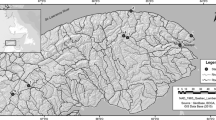Abstract
The accuracy of reconstructing missing daily temperature extremes in the Jaffna climatological station, situated in the northern part of the dry zone of Sri Lanka, is presented. The adopted method utilizes standard departures of daily maximum and minimum temperature values at four neighbouring stations, Mannar, Anuradhapura, Puttalam and Trincomalee to estimate the standard departures of daily maximum and minimum temperatures at the target station, Jaffna. The daily maximum and minimum temperatures from 1966 to 1980 (15 years) were used to test the validity of the method. The accuracy of the estimation is higher for daily maximum temperature compared to daily minimum temperature. About 95% of the estimated daily maximum temperatures are within ±1.5 °C of the observed values. For daily minimum temperature, the percentage is about 92. By calculating the standard deviation of the difference in estimated and observed values, we have shown that the error in estimating the daily maximum and minimum temperatures is ±0.7 and ±0.9 °C, respectively. To obtain the best accuracy when estimating the missing daily temperature extremes, it is important to include Mannar which is the nearest station to the target station, Jaffna. We conclude from the analysis that the method can be applied successfully to reconstruct the missing daily temperature extremes in Jaffna where no data is available due to frequent disruptions caused by civil unrests and hostilities in the region during the period, 1984 to 2000.






Similar content being viewed by others

References
Allen RJ, DeGaetano AT (2001) Estimating missing temperature extremes using an optimized regression approach. Int J Climatol 21:1305–1319. doi:10.1002/joc.679
Daly C (2006) Guidelines for assessing the suitability of spatial climate data sets. Int J Climatol 26:707–721. doi:10.1002/joc.1322
DeGaetano AT, Eggleston KL, Knapp WW (1995) A method to estimate missing maximum and minimum temperature observations. J Appl Meteorol 34(2):371–380
DeGaetano AT, Belcher BN (2007) Spatial interpolation of daily maximum and minimum air temperature based on meteorological model analyses and independent observations. J Appl Meteor Climatol 46(11):1981–1992
Domroes M, Ranatunge E (1993) A statistical approach towards a regionalization of daily rainfall in Sri Lanka. Int J Climatol 13(7):741–754
Efstathiou MN, Tzanis C, Cracknell AP, Varotsos CA (2011) New features of land and sea surface temperature anomalies. Int J Remote Sens 32:3231–3238
Eischeid JK, Baker CB, Karl TR, Diaz HF (1995) The quality control of long-term climatological data using objective data analysis. J Appl Meteorol 34:2787–2795
Elshorbagy A, Panu SU, Simonovic SP (2000) Group-based estimation of missing hydrological data: I. Approach and general methodology. J Hydrol Sci 45(6):849–866
Huth R, Nemesova I (1995) Estimation of missing daily temperature: can a weather categorization improve its accuracy. J Clim 8(7):1901–1916
Islam N, Doscher C, Davies T (2000) Estimating daily maximum and minimum temperature for mount cook, South Island, New Zealand using statistical model and ‘aiNet’ neural network models. J Hydrol 39(2):83–106
Kemp WP, Burnell DG, Everson DO, Thomson AJ (1983) Estimating missing daily maximum and minimum temperatures. J Climate Appl Meteor 22(9):1587–1593
Kiraly A, Bartos I, Janosi IM (2006) Correlation properties of daily temperature anomalies over land. Tellus A 58:593–600
Puvaneswaran KM, Smithson PA (1993) An objective classification of homogeneous rainfall regimes in Sri Lanka. Theo Appl Climatol 48(2–3):133–145
Thevakaran A, Sonnadara DUJ (2013) Reconstruction of missing monthly temperature observations in Jaffna-Sri Lanka. J National Sci Foundation 41(1):21–28
Varotsos C, Efstathiou M, Tzanis C, Deligiorgi D (2012) On the limits of the air pollution predictability: the case of the surface ozone at Athens, Greece. Env Sci Poll Res 19:295–300
Xia Y, Fabian P, Stohl A, Winterhalter M (1999) Forest climatology: estimation of missing values for Bavaria, Germany. Agri Forest Meteorol 96(1–3):131–144
Acknowledgments
Financial support by Higher Education for the Twenty First Century (HETC) Project assisted by the World Bank (IDA Credit 49190-LK) is acknowledged.
Author information
Authors and Affiliations
Corresponding author
Rights and permissions
About this article
Cite this article
Thevakaran, A., Sonnadara, D. Estimating missing daily temperature extremes in Jaffna, Sri Lanka. Theor Appl Climatol 132, 145–152 (2018). https://doi.org/10.1007/s00704-017-2082-0
Received:
Accepted:
Published:
Issue Date:
DOI: https://doi.org/10.1007/s00704-017-2082-0



